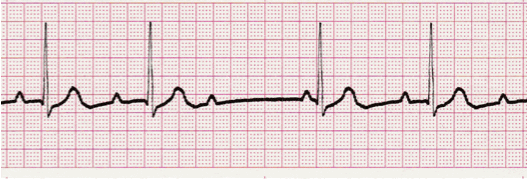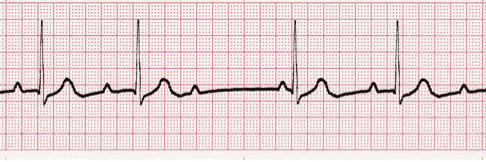Second Degree Heart Block Type I - Heart Blocks
Description
- Also known as Wenckebach Phenomenon; second degree heart block ECG dysrhythmia is typically stable and often temporary with the patient remaining asymptomatic as long as the ventricular response remains within the “normal” range.
- The unique feature (hallmark) of this dysrhythmia is the presence of a prolonging P-R interval from one cardiac complex to the next, until it reaches a point where the QRS complex is non-conducted ( blocked or more simply missing). Then the pattern starts over again.
Example
- In this dysrhythmia, if the third QRS complex is dropped/blocked, then it will always be the third complex that is blocked before re-setting in a repetitious pattern.
- It is important to note the following:
- The P – P intervals are regular and the R to R intervals are irregular.
- here are more P waves than QRS complexes. Report the rate of each separately.

Practice Strip

Analyze this tracing using the five steps of rhythm analysis.
Show Answer
- Rhythm: Atria – Regular, Ventricles - Irregular
- Rate: Atria – 56, Ventricles - 40
- P Wave: Upright
- PR interval: Variable, progressive
- QRS: 0.10 sec
- Interpretation: Second Degree Heart Block Type I
Authors and Sources
Authors and Reviewers
- EKG heart rhythm modules: Thomas O'Brien.
- EKG monitor simulation developer: Steve Collmann
-
12 Lead Course: Dr. Michael Mazzini, MD.
- Spanish language EKG: Breena R. Taira, MD, MPH
- Medical review: Dr. Jonathan Keroes, MD
- Medical review: Dr. Pedro Azevedo, MD, Cardiology
- Last Update: 11/8/2021
Sources
-
Electrocardiography for Healthcare Professionals, 5th Edition
Kathryn Booth and Thomas O'Brien
ISBN10: 1260064778, ISBN13: 9781260064773
McGraw Hill, 2019 -
Rapid Interpretation of EKG's, Sixth Edition
Dale Dublin
Cover Publishing Company -
12 Lead EKG for Nurses: Simple Steps to Interpret Rhythms, Arrhythmias, Blocks, Hypertrophy, Infarcts, & Cardiac Drugs
Aaron Reed
Create Space Independent Publishing -
Heart Sounds and Murmurs: A Practical Guide with Audio CD-ROM 3rd Edition
Elsevier-Health Sciences Division
Barbara A. Erickson, PhD, RN, CCRN -
The Virtual Cardiac Patient: A Multimedia Guide to Heart Sounds, Murmurs, EKG
Jonathan Keroes, David Lieberman
Publisher: Lippincott Williams & Wilkin)
ISBN-10: 0781784425; ISBN-13: 978-0781784429 - Project Semilla, UCLA Emergency Medicine, EKG Training Breena R. Taira, MD, MPH